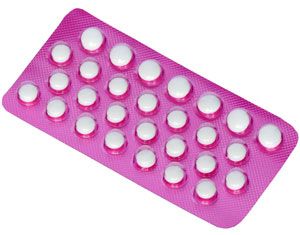The first contraceptive pill became available in 1961 in the UK and revolutionised many women’s lives. Even though it is now one of the most popular and widely used forms of contraception, young women interested in using the pill are often confused and have many questions. Here we hope to answer them all.
What is it?
 The contraceptive pill is usually just called the pill, or COC pill. It contains synthetic (artificial) versions of the female hormones oestrogen and progesterone, which are produced naturally in ovaries. It’s these hormones that prevent you from getting pregnant.
The contraceptive pill is usually just called the pill, or COC pill. It contains synthetic (artificial) versions of the female hormones oestrogen and progesterone, which are produced naturally in ovaries. It’s these hormones that prevent you from getting pregnant.
When taken correctly, the pill has a high success rate of over 99%.
Although the pill isn’t just used for contraception; it can help with heavy/painful periods – making your bleeds regular and lighter. Additionally it can reduce symptoms of premenstrual syndrome and even lessen the appearance of acne.
How does it work?
Primarily, the hormones in the pill prevent pregnancy by stopping your body from ovulating (releasing an egg), but it has additional functions:
- Thickens mucus in the neck of the womb which makes it difficult for sperm to permeate and fertilise an egg.
- Thins the lining of the womb so there is less chance of a fertilised egg implanting and being able to grow.
Two main types of pill
There are combined oral contraceptive pills (COCs) which contain two hormones, an oestrogen and a progestogen and progestogen only pills (POPs or mini-pills) which contain only a progestogen.
Combined pills are usually slightly more reliable in preventing pregnancy and in regulating periods. Progestogen only pills (POPs), contain lower doses of hormone and tend to have fewer side effects.
Types of Combined Pills
Monophasic 21-day pills
This type of pill is generally the most common and there are many different brands, such as Microgynon, Brevinor and Cilest, to name just a few. Each type has a different level of active ingredients and your GP will help you decide which is best for you.
Each pill in the pack contains the same amount and type of hormone. These are taken every day for 21 days and then no pills for the next 7 days. You can also take the pills continually without a break.
Phasic 21-day pills
Phasic pills, such as Binovum and Logynon, need to be taken in the right order as they contain two or three sections of different coloured pills in a pack. Each section contains a different amount of hormones. One pill is taken each day for 21 days and then no pills are taken for the next 7 days.
Every day (ED) pills
As is expected, every day pills are to be taken every day and in the right order. As with other types of combined pill there are a number of different brands to choose from, all including ED in the name, such as Microgynon ED and Logynon ED.
There are 21 active pills and 7 inactive (dummy) pills in a pack. The two types of pill look different. One pill is taken each day for 28 days with no break between packets of pills.
Whichever pill you take, there will be instructions in the packet. Read these carefully before taking them as failing to comply could result in them not being effective.
How to start the combined pill
Most women can start the pill at any time in their menstrual cycle.
If you start the pill on the first day of your period, you will be protected from pregnancy straight away. If you start the pill on the fifth day of your period or before you will still be protected from pregnancy straight away, unless you have a short menstrual cycle. In this case condoms should be used for up to 7 days.
If you start the pill on any other day of your cycle you will not be protected from pregnancy straight away and will need additional contraception until you have taken the pill for 7 days.
Side effects
Minor side effects can include mood swings, breast tenderness and headaches.
The risks
As with anything, there are a few risks to be aware of before taking the pill. Reassuringly, these risks are small, but it’s important to weigh up any benefits and risks when making decisions about contraception.
Blood clots can be caused from the pill as oestrogen causes the blood to clot more easily. This can lead to thrombosis and strokes/heart attacks. However, this risk is minimal and certain factors make people more vulnerable.
There are a number of reasons that people are advised not to take the pill. They include:
- Being 50 years old or over
- Being a smoker or recent smoker (past year)
- Being overweight
- Suffering from migraines
- Having high blood pressure
- Having clots run in the family
- Being immobile (e.g. a wheelchair)
Cancer research is still being conducted but there may be a link between certain cancers and the pill. These include breast cancer, cervical cancer and a rare form of liver cancer. However, research has also suggested that the pill offers protection against some cancers, including endometrium (lining of womb), ovarian and colon cancer.
Where you can get the combined pill?
There are various ways you can get the pill. The services are confidential, including for people under the age of 16. Here’s where you can find them:
- Local GP
- Contraception/Sexual health clinics.
- You can also get it online from our UK registered pharmacy if you have been prescribed it before.



